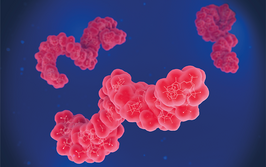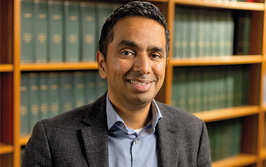Marker of Excellence
Sitting Down With… Professor Anthony Whetton, Director of the Stoller Biomarker Discovery Centre, Manchester, UK

How did you get involved in the biomarker field?
My focus has been leukemia research since 1984. I began working with proteomics in 1999, and then moved into biomarker discovery, simply through wanting to do the best possible research for the most clinical impact. We soon started using our proteomics platform outside leukemia – for example, biofluids analysis – to identify markers relevant to cancer. Consequently, we applied for £13 million Medical Research Council (MRC) funding to develop the Stoller Biomarker Discovery Centre, which is now the largest clinical proteomics center in Europe.
How difficult was it to muster the resources needed to win the MRC grant?
It relied on teamwork. First, we pulled together stratified medicine groups with expertise in psoriasis, lupus, arthritis, and cancer – everything starts with clinical need. Then we co-operated to show the MRC that we had the ideal basis for development of a transformational biomarker discovery platform. But it took 4–5 iterations before we got the award, and each one was more difficult than the last. I still find it hard to believe that we succeeded!
You have 13 mass specs – why have you chosen to invest so heavily in this technology?
It’s the best technology for discovery proteomics, and the instruments get better and more sensitive every year; for example, it’s clear that SWATH-MS markedly increases efficiency. So we concluded that the industrialization of proteomics would be best-served by adopting mass spectrometry (MS) technology. There are other approaches to proteomics – for example, antibody arrays – but we think MS is best for biomarker discovery.
How important are collaborations to you?
We’ve always sought collaborations to identify disease-associated biomarkers, and we continue to invite collaboration on biofluid and tissue sets from other centres. One collaboration with Tessa Holyaoke at the University of Glasgow has led to a potentially curative strategy for chronic myeloid leukaemia (1) which I hope will soon be in clinical trials. That development could not have happened in either institute alone.
How long does it take to develop a new biomarker into a clinical CDx?
Too long – about 10 years. One problem is that samples aren’t collected early enough in the clinical study, due to issues such as cost, time and availability of research nurses. But another point is that you need a very well-regulated laboratory environment, including a recording regime which passes regulatory scrutiny. At the Stoller Centre, we work to the highest relevant standards as early as possible. This will compress the period between biomarker discovery and clinical application – our target is to bring four biomarkers to the clinic in the next five years. Our quality regime is aimed at meeting international standards – including MHRA, FDA and EMA requirements – and covers MS, antibody-based assays, sample storage, laboratory information management systems and informatics.
Is global investment in biomarker research reflected in approvals of new CDxs?
No – the rate of biomarker regulatory approvals isn’t changing, perhaps because biomarker development is so hard. You must address issues including statistical surety, sensitivity, specificity – which must be very high to support a biomarker launch. You cannot afford to get it wrong. It’s just not acceptable to have a high false positive or negative rate.
What will be the impact on healthcare budgets of increased CDx use?
There are obvious clinical and health economic benefits to using a biomarker test to assess responsiveness before or just after initiation of treatment. For example, if you treat patients with expensive biologics, at £10,000/ year, for months before you know whether they respond to it, that’s not good for the health service, the taxpayer or the patient. But biomarkers help to get the right drug to the right patient at the right time. There are good exemplars of this in leukemia – for example, in CML you test for the chromosomal translocation encoding BCR-ABL, which indicates treatment with tyrosine kinase inhibitors.
What role does informatics and big data play in biomarker development?
Informatics tools support digitization of the proteomic map for any individual, and association of the map with an electronic healthcare record. And that allows you to identify false positives and false negatives and develop the test surety. Furthermore, future CDx will not rely on single markers, but will use algorithms to derive information from multiple measured factors, and this too will require informatics capabilities. Applying informatics to proteomic data will allow accommodation of co-morbidities, concomitant medications, and other confounding factors, thus enabling development of algorithms with high sensitivity and surety.
How important is pathology expertise?
It’s a fantastic asset! We absolutely need pathology expertise to move from the lab to clinical usage as swiftly as possible. That’s why we applied for and obtained another £3 million from the MRC to build the pathology node, led by Tony Freemont, which takes our discoveries and translates them into something of clinical value. This integration of expertise will allow us, ultimately, to improve healthcare outcomes for everyone.
- SA Abraham et al., “Dual targeting of p53 and c-MYC selectively eliminates leukaemic stem cells”, Nature, 8, 534, 341–346 (2016). PMID: 27281222.

After graduating with a pharmacology degree, I began my career in scientific publishing and communications. Now with more than 16 years of experience in this field, my career has seen me heading up editorial and writing teams at Datamonitor, Advanstar and KnowledgePoint360 group. My past experiences have taught me something very important – that you have to enjoy working with, and have respect for your colleagues. It’s this that drew me to Texere where I now work with old colleagues and new. Though we are a hugely diverse team, we share several things in common – a real desire to work hard to succeed, to be the best at what we do, never to settle for second best, and to have fun while we do it. I am now honored to serve as Editor of The Pathologist and Editorial Director of Texere Publishing.




















